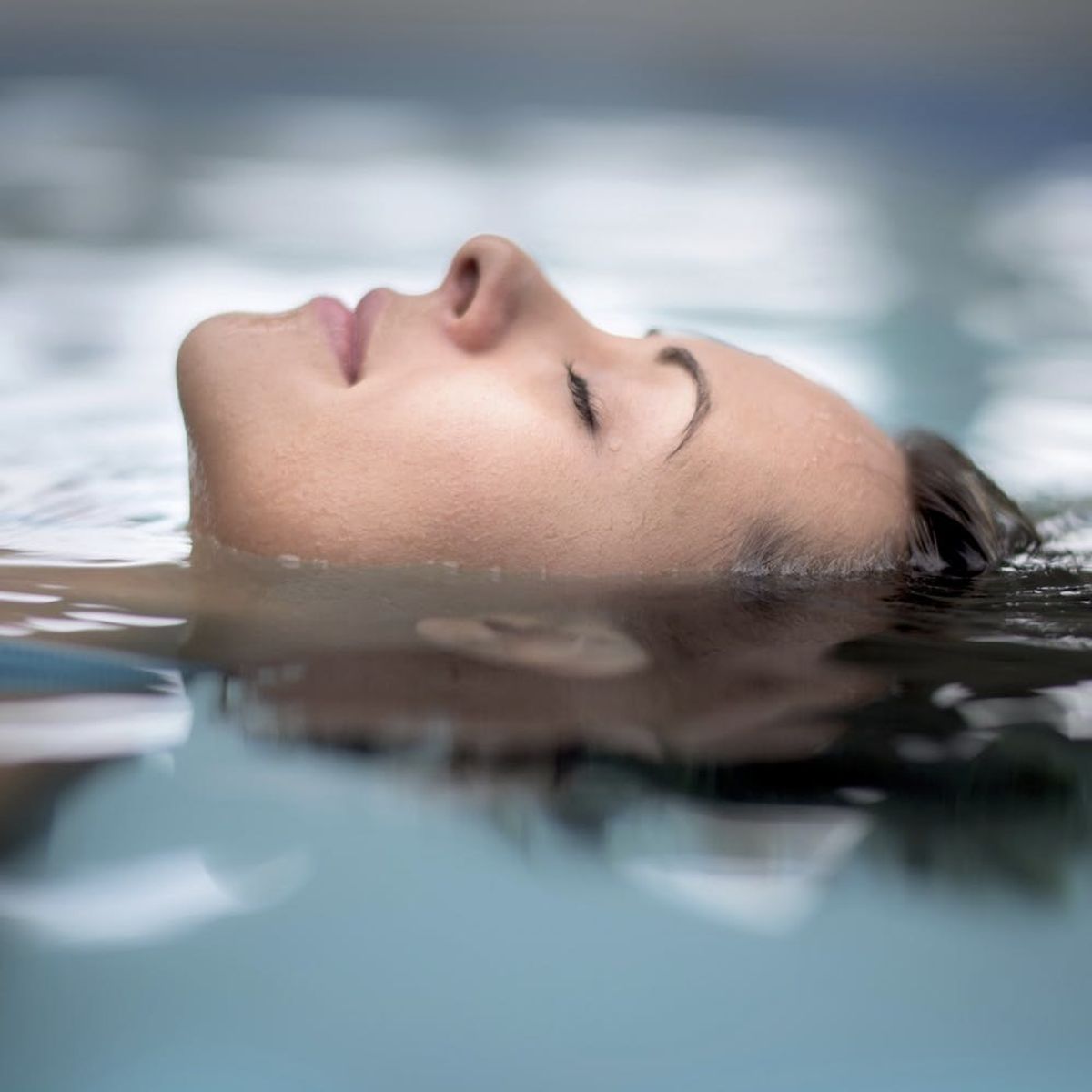Let your worries float away.
I Tried Floatation Therapy + Here’s What Happened

When you think about sensory deprivation (which you obviously do all the time), deep relaxation and meditation probably aren’t the first two things that come to mind. The idea of shutting yourself off from all sound, light and physical touch probably evokes feelings of anxiety more than anything — who wants to be that vulnerable, after all? But according to floatation therapy tank enthusiasts, it’s in that space (AKA a futuristic looking water pod) where we can truly relax.
SO, WHY FLOAT IN DARKNESS?
The idea behind floating is simple: Spending an hour in a tank filled with 10 inches of water and about 800 pounds of Epsom salt, without any stimulation to distract us, lowers our heart rate, blood pressure and muscle tension, thereby reducing stress. Also, when we’re relaxed, our bodies release endorphins, the happy chemical. One of the coolest benefits you may not think about is that when we’re floating, we’re free of the effects of gravitational pull, like chronic aches and pains. So the float gives our minds and bodies a chance to recuperate and rejuvenate, because we’re not so focused on any discomfort (lower back or shoulder pain, anyone?).
While floating has been around since 1954, when Dr. John C. Lilly invented the first sensory deprivation tank for therapeutic purposes, it’s recently seen an uptick in popularity in the natural wellness community. I’ve already tried upping my meditation game with the Breathe app and swear by YouTube yoga workouts to help center myself, but I’m always looking to add something new to my wellness regimen and had to give float therapy a shot.
PRE-FLOAT RELAXATION VIBES AT FLOAT ZONE
I opted for an 8PM float session to transition that promised uber-relaxed feeling into major sleepy time vibes. When I arrived at the Float Zone, the lovely barefoot man behind the reception desk had me watch a short video that explained the float process, took my shoes and showed me around the post-float lounge, which was well-equipped with adult coloring books, hot tea and comfy couches, should I want to extend my relax sesh.
He finally led me to my float room, wished me a peaceful float and closed the door behind me. Each room has a private shower, so you can wash off any makeup, lotion, sunscreen or perfume that might muck up the water inside the tank before you float. And yes, you float completely naked.
View this post on InstagramA post shared by dont call me julia (@julie.rn.arturo) on
WHAT HAPPENED DURING MY HOUR-LONG FLOAT
The tank was much bigger than I was expecting, which was a welcome surprise. After I got in and closed the lid, I could still practically remain vertical (I’m 5’1″). I’m not particularly claustrophobic, but I’d had coffin-like visions in my head earlier that day and was a bit apprehensive.
Thankfully, “sensory deprivation” is a relative term. I had the option for both a soft blue light and new age-y music inside the tank that I could turn on and off by pressing two buttons on its side. I initially tried to commit to the full experience, with silence and darkness surrounding me, but I grew distracted and bored pretty quickly and decided that the soft stimulation of light and music actually helped me relax.
Most floaters say it takes about 15 minutes to become accustomed to the tank and fully relax, while the remaining 45 go by in a blissed-out blur of deep meditation. I’d say, as a float newbie, I needed a good 25 minutes to finally chill (and stop giggling when I gently crashed into the side of the tank) but could quite literally feel the stress in my mind and tension in my body melting off me as the minutes went by.
The Epsom salts in the float tank are meant to not only keep you afloat but help detox your body and relax your muscles. I’d just done a killer 10-mile hike a few days before my float and my calves were still burning like a row of six fire emojis. Post-float, I definitely noticed a major difference in how they felt, as well as an overall Jell-O like sensation through my whole body that I was not mad at.
HOOKED ON THE FEELING, NOT THE PRICE
Mentally, I felt clear, happy and stress-free. That general feeling of contentment and peace made me wish I could float every night before bed. I got an amazing night’s sleep and woke up feeling refreshed, though the effects didn’t last much longer than that. Once I was back to the regular rhythms of the day, those good float feelings were gone. At $65 a session, floating is a bit spendy to do on the regular for my lifestyle, but I’d consider it a worthwhile indulgence when I’m feeling particularly frazzled.
Would you try a float tank to meditate and relax? Tweet us @BritandCo.
(Photos via Getty and Float Zone)












